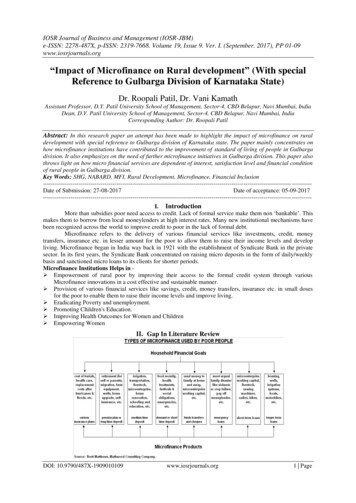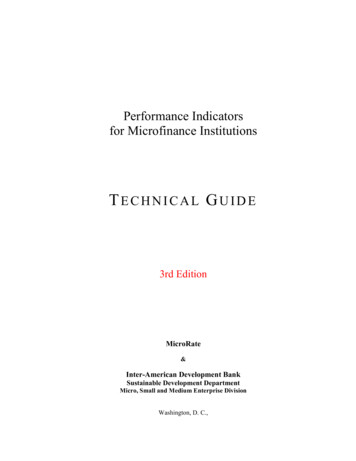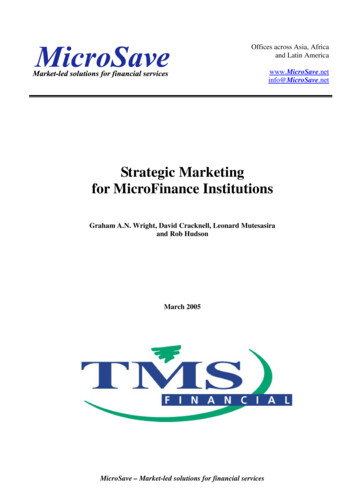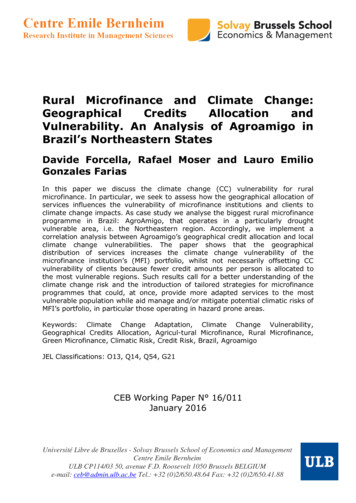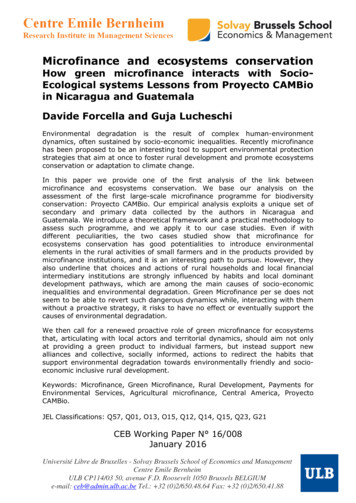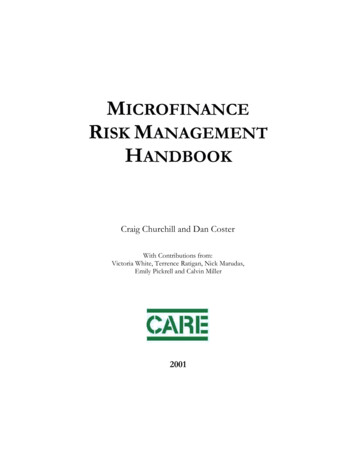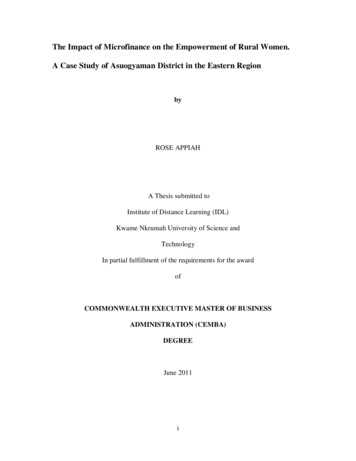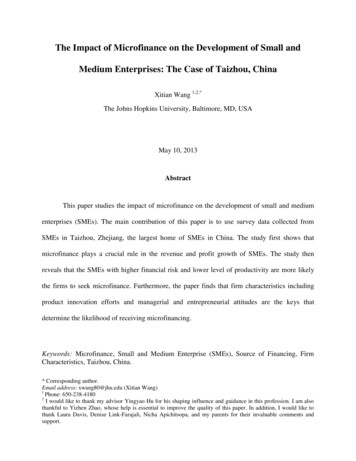
Transcription
The Impact of Microfinance on the Development of Small andMedium Enterprises: The Case of Taizhou, ChinaXitian Wang 1,2,*The Johns Hopkins University, Baltimore, MD, USAMay 10, 2013AbstractThis paper studies the impact of microfinance on the development of small and mediumenterprises (SMEs). The main contribution of this paper is to use survey data collected fromSMEs in Taizhou, Zhejiang, the largest home of SMEs in China. The study first shows thatmicrofinance plays a crucial rule in the revenue and profit growth of SMEs. The study thenreveals that the SMEs with higher financial risk and lower level of productivity are more likelythe firms to seek microfinance. Furthermore, the paper finds that firm characteristics includingproduct innovation efforts and managerial and entrepreneurial attitudes are the keys thatdetermine the likelihood of receiving microfinancing.Keywords: Microfinance, Small and Medium Enterprise (SMEs), Source of Financing, FirmCharacteristics, Taizhou, China.* Corresponding author.Email address: xwang80@jhu.edu (Xitian Wang)1Phone: 650-238-41802I would like to thank my advisor Yingyao Hu for his shaping influence and guidance in this profession. I am alsothankful to Yizhen Zhao, whose help is essential to improve the quality of this paper. In addition, I would like tothank Laura Davis, Denise Link-Farajali, Nicha Apichitsopa, and my parents for their invaluable comments andsupport.
1. IntroductionThe rise of small and medium enterprises (SMEs) in China is gaining increasing attentionworldwide. The production of SMEs accounted for over 60% of China’s total GDP by March of2012, increasing from 1% in the 1980s 1. However, SMEs in China have been facing challengesof financing or refinancing since their birth as it is difficult to obtain conventional loans fromcommercial banks to start up small or medium scale enterprises. The main reason is thatcommercial banks demand collateral before giving loans for business purposes. The higher therisk the business has the more the collateral the banks need to charge, whereas SMEs are subjectto higher risk and easily default. The limited funding sources of SMEs make the issue ofproviding sufficient collateral even worse. The high collateral demanded by commercial banksbasically cuts the official channel of SMEs in obtaining loans. Thus, the difficulty of access toloans from state financial institutions such as commercial banks constitutes a great setback toentrepreneurial development.One of the responses to the challenges of the lack of financing options for SMEs is theintroduction and development of microfinance. According to the China Association ofMicrofinance, microfinance in China refers to financial services provided for the middle and lowincome population that cannot get loans from traditional banks. Microfinance has the ability tostrengthen SMEs and encourage best practices among operators of SMEs. In terms of supply ofmicrofinance, diversified microfinance suppliers and supply channels have emerged in Chinasince the 1990s. However, the overall volume of supply is limited, and the majority of suchsupply is in its experimental stage. From the perspective of demand, there are various types ofpeople in need of microfinance, including urban laid-off workers, rural households, andmicroentrepreneurs. At the same time, the types of demand for microfinance services is also2
diversified, such as microcredit, microsavings, microinsurance, and investment (He, Du, Bai, andLi, 2009)2.The paper is organized in the following way. Section 2 is a literature review that aids theanalysis and establishes some hypotheses. Methodology, including a brief description of thesurvey from which the data for this study was drawn, is interpreted in Section 3. Section 4reports the results of the research, and Section 5 summarizes findings and key conclusions.2. Literature Review and FrameworkA number of studies have been conducted on microfinance and SMEs in China. ChinaMicrofinance Industry Assessment Report provided by the China Association of Microfinancegives the definition of microfinance in China, and examines the impacts of microfinancedevelopment at macro, meso, and micro levels, spanning over agricultural industry, financialmarkets, and social vulnerable groups such as women and farmers (He, Du, Bai, and Li, 2009).Many studies then have focused on each level specifically. Li (2006)3 concludes thatmicrofinance has offered an effective finance method for the construction of new socialist ruralregions and has won the support of agriculture and farmers. Dyar, Harduar, Koenig, and Reyes(2006)4 together examine the impact of microfinance on gender inequality in China and havediscovered that there are many benefits to providing microfinance to women, despite lack ofconclusive evidence on significantly reducing gender inequality. Microfinance allows women toenjoy greater economic power, better living quality, and stronger social and politicalempowerment. Park, Ren, and Wang, (2004)5 assess the potential role of microfinance forfinancial reform in China and suggest that China’s financial reforms have yet to create an3
institutional space in which microfinance can operate, thrive, and expand. Therefore, expansionof microfinance will almost definitely have to await substantial further progress in creating awell-developed commercial, financial system. In the meantime, however, microfinance programsare competing with China’s official financial institutions and levying pressure on the practiceand reform of the rigid state-owned financial institutions.In addition to research on reform, studies have also been conducted on the structure ofmicrofinance. Sun (2008)6 studies the policy and legal framework for microfinance in China andsuggests that the Chinese government will have to continue to focus on improving the legal andpolitical environment for microfinance if the industry is to continue to grow and prosper. Parkand Ren (2001)7 study the nongovernmental and governmental microfinance programs fromcultural perspective and find that nongovernmental programs perform well in aspects of reachingthe poor (targeting), guiding financial and operational performance (sustainability), andestablishing program benefits (impact). Meanwhile, Tsai (2004)8 points out four reasons for theexistence of informal microfinance service: i. the limited supply of formal credit; ii. limits instate capacity to implement its policies; iii. the political and economic segmentation of localmarkets, and the institutional weakness of many microfinance programs.To study the development of SMEs in China per se, Chen (2006) 9 gives an overview ofthe historical development and current status of Chinese SMEs and examines major politicalinitiatives contributing to the development of SMEs. Liu and Yu (2008) 10 look into the structureof China’s financial system and argue that insufficient development of rural SMEs and regionaldivergence in SME development are important causes of urban-rural income inequality. Shen,Shen, Xu, and Bai (2009)11 further examine how bank size, discretion regarding credit, incentiveschemes, industrial competition, and institutional environment could affect lending.4
As we can see, little research has found the connection between microfinance and theprofitability of SMEs. We have seen the research conducted in Africa that aims to find theimpact of microfinance on entrepreneurial development in Nigeria. However, countries in Africaare less developed. The impact of microfinance is not significant. The main contribution of thispaper is to focus on China - the most fast-developing country – by using a primitively-designedsurvey and by collecting two waves of panel data in 2010-2011 to study the relationship betweenthe profitability and the microfinance of small and medium enterprises. The paper shows thatmicrofinance plays a crucial rule in the revenue and profit growth of SMEs. The paper alsoreveals that the SMEs with higher financial risk and lower level of productivity are more likelythe firms seek to microfinance. Furthermore, the paper finds that firm characteristics includingproduct innovation efforts and managerial and entrepreneurial attitudes are the keys thatdetermine the likelihood of receiving the microfinancing.3. Methodology3.1. Questionnaire and SampleThe data used in this paper is derived from investigation results of a primitively-designedquestionnaire (see Table 1). The independent survey was conducted from January to March,2013. This questionnaire was designed to collect information on SME characteristics and thesource of financing. The questionnaire contains three parts. The first collects information on thecharacteristics of the SME, focusing on basic characteristics including industry, size (number ofemployees), age, level of productivity, and its breakdown by education, and innovationcapability from 2010 and 2011. The second part gathers information on the performance of firms5
including revenue and net profit. The third part collects the financial information including theparticipation of microfinance, the amount of microfinancing, and the weight of each financedamount for future investments.Many basic characteristics were conducted for the survey. Firm size is defined in terms ofnumber of employees and SMEs are defined as those with employees less than 2000. Out of 323effectively surveyed firms, 211 fall into this category. An effective survey is one which answersall the questionnaire questions and answers are valid based on common sense. For example, asum of weights in each respective financed amount equaling 100% is considered a valid answer.Particularly, a firm with less than 2000 employees but more than 300 employees is considered amedium enterprise, while a firm with less than 300 employees is considered as small enterprise12.Table 2 summarizes the key characteristics of the effective surveyed SMEs. SMEs withemployees less than 300 accounted for 85.8% of the total, following by 12.3% of firms withemployees of more than 300 but less than 2000. The average age of the SMEs was more than11.6 years.The source of financing for firms is divided into four categories including microfinance,retained earnings, personal funds, and other. According to effectively surveyed SMEs, thenumber of those that used microfinance in 2010 and in 2011 was 73 and 76, accounting for34.6% and 36.0% of the total surveyed SMEs, respectively. There were only four SMEs thatparticipated in microfinance in 2010 that didn’t participate again in 2011. Similarly, there wereonly seven SMEs that participated in microfinance in 2011 that were not among the SMEs thatparticipated in microfinance in 2010. Among four sources of financing, microfinance accountsfor 11.9% on the average for the surveyed SMEs.6
Small adjustments may be made during the collection of data in ways to keep logical andconsistent. For example, for the SMEs that filled in the amount of microfinancing in thequestionnaire but did not indicate whether or not they used microfinance during a given year, Iassumed that they used microfinance; otherwise, the amount of microfinancing wouldn’t beapplied. As a result, for inferable incomplete or missing information in the survey, I inferred thenumber during the data entry process. I did not try to substitute the missing data (requested byquestionnaire) that needed predictions because this data already contained errors and the existinginformation from the surveys was not reliable enough to generate predicted values. Adjustmentsmade and missing information significantly reduced the effective observations for econometricanalysis from approximately 323 to 211 SMEs.The questionnaire doesn’t study the total capital for each individual firm directly. In orderto estimate the capital amount, the following assumptions have been made. First of all, the paperassumes the total amount of capital equals the total source of financing, which is the sum ofmicrofinancing, retained earnings, personal funds, and other sources. Second, if capital is adependent variable, while labor and level of productivity are independent variables, there exists alinear relationship between the dependent variable and the independent variables. As such, thecapital of the SME is estimated by the following ways. Given the amount of microfinancing andweight of microfinancing, I first calculated the total capital by dividing the amount ofmicrofinancing by its weights. I then regressed those with nonzero capital amounts on thenumber of employees and the level of productivity. After that, I used the estimated coefficientsto impute capital amounts for those SMEs with zero capital amount using their labor and levelproductivity. By doing that, 46 negative observations were eliminated and the paper successfullyfit the rest of 165 SMEs with nonzero capitals.7
3.2. Statistical MethodThe determinants of SME development in terms of revenue growth and net profit growthare examined by way of statistical regression. The statistical model will use multiple linearregression model and parameters are estimated by Ordinary Least Square (OLS) method as Wherewithis the intercept,, and so on. is the parameter associated with ,is the parameter associatedis the error term.The multiple linear regression model is applied because it is easier to adjust independentvariables as it allows us to explicitly control many other factors that could simultaneously affectthe independent variable. In addition, the regression model can match fairly general functionalform relationships. Table 3 studies the impact of independent variables on the development ofSMEs in terms of net profit growth, where i represent firm i, Xi represents the variable onindependent variables that we are interested. Table 4 is in the similar spirit of Table 3 except thatthe dependent variable is the revenue growth from 2010 to 2011.3.3. Measurement of VariablesThe following variables are used to classify firm characteristics. Firm size is measured bynumber of employees instead of average annual revenue. By doing this, sensitivity to the changesin the business cycle or macroeconomics variables can be largely eliminated. Meanwhile, the ageof the firm is proxied by the number of years the plant has been in commercial production.8
The sources of funds are measured by the percentage of different sources accounting forthe total investments in a certain year. It is noteworthy that the total amount of one year’sinvestment (working capital) and the percentage of each source largely depend on the firm’sperformance during the previous year in terms of revenue growth and net profit growth.Therefore, this paper uses the dependent variables in 2010 to regress the change in independentvariables from 2010 to 2011.The measurement of SMEs productivity is based on the self-assessment. The surveyedSME is asked to score its level of productivity on a scale of 0 to 10. A score of 0 means the leastproductive while a score of 10 means the most productive. Each SME is asked to measure itslevel of productivity in 2010 and 2011. This paper chooses to use self-reported scores because itis very hard to measure productivity given the limited information. Given the output function,labor and capital are the two main factors. Therefore, this paper studies the number of employeesand their self-scored level of productivity.The measurement of SME characteristics in terms of a firm’s product innovation effortsare employed in Harvie (2010)13’s Firm Characteristic Determinants of SME Participation inProduction Networks. The article points out that in measuring the extent of a firm’s productinnovation efforts, four dummy variables could be employed to identify whether a firm has: (1)bought new machines, (2) improved its existing machinery, (3) introduced new know-how orknowledge into its production, and (4) introduced new products or services onto the market. Thevalue of each of these variables is equal to unity if a firm has a conducted effort attached to eachof these variables in the 2010 and 2011 period from the survey, or zero otherwise.9
Harvie (2010) also indicates that two dummy variables are necessary to capture firmmanagerial and entrepreneurial attitudes. The first dummy variable is created to identifyperceptions about taking business risks. It takes the value of unity if managers/owners have apositive attitude towards taking business risks or zero otherwise. The second dummy variable iscreated to identify willingness of the managers/owners to adopt a new business strategy. Thevariable takes the value of unity if there is a positive attitude towards adopting a new businessstrategy or zero otherwise. This paper chooses to study the latter one but not the first one becausewhether the firm has a positive attitude or not towards taking business risks is rather subjective.Moreover, this paper studies whether the firm has adopted the new business strategy or not,instead of asking about the willingness.In addition, the paper also introduces the availability of training as one of thecharacteristics of each SME. The availability to train is a very important criterion in forecastingthe growth of a SME and its level productivity. SMEs who train their employees frequently tendto have a higher productivity and better employees satisfactions. The paper attempts to furtherreveal its relationship with participation in microfinance and development of SMEs in thefollowing analysis.4. Results and AnalysisThe paper focuses on the effects of microfinance on the following year’s SMEsperformance. In order to measure the impact of microfinance on the development of SMEs, Ifirst regressed the growth rate of net profit from 2010 to 2011 on the key factors of SMEs, whichincluded capital, number of employees, level of productivity, and weight of microfinancing in10
terms of total capital (%) within 2010. These are essential factors in determining the SMEs’output. Column (1) of Table 3 reports the statistical inference results of the regression.Results in Column (1) of Table 3 indicate that using microfinance brings a significantlyhigher profit to SMEs than those that did not. Having microfinancing to be one of the capitalsources is important in 2010. The estimated coefficient of the weight of microfinancing in termsof total capital in 2010 (%) is the largest positive number among other coefficients. Moreover,the value of the estimated coefficient suggests that the effect of the amount of microfinance isalso significant. It suggests that the SMEs that doubled the weight of microfinancing during 2010would have 3.0% more net profit growth than those that did not from 2010 to 2011, holding allothers equal. The results also indicate that the SMEs with more employees and a higher level ofproductivity tend to have a higher net profit growth. The estimated coefficient suggests that forevery 1 point of increase in productivity, the net profit growth is higher by 7.3%.I regressed the revenue growth from 2010 to 2011 on the same factors I had for theregression on net profit growth. Column (1) of Table 4 reports the statistical results. The numberof employees and the level of productivity still show positive effects on the revenue growth.However, the impact of having more microfinancing among the total capitals (%) is counterintuitive. In fact, the signs of estimated coefficients suggest that the effects of having moremicrofinancing among the total capitals are negative. Particularly, the value of the estimatedcoefficient suggests that on the average, the SMEs that doubled the weight of microfinancing(%)during 2010 would have approximately 29.3% lower revenue growth from 2010 to 2011, holdingall others equal.11
These results were unexpected. In order to further investigate the problem, the paper firstattempts to unveil those factors that determine the probability of participating in microfinancing.I performed Tobit regression of dependent variables Weight of Microfinance 2011 (%) andParticipation in Microfinance in 2011 on independent variables including Revenue Growth from2010 to 2011, Level of Productivity in 2010, and Retained Earnings (%) in 2010.Table 5 shows the statistical results. From both column (1) and column (2) in Table 4, theestimated coefficient suggests that the effects of the productivity and retained earnings arenegative. From column (1) in Table 4, the coefficient of the level of productivity indicates thaton the average, an increase in the level of productivity by 1 will decrease the weight ofmicrofinancing (%) by about 2.9%. Moreover, on the average, doubling the weight of retainedearnings (%) will decrease the weight of microfinancing (%) by 14.0%. From column (2) inTable 5, on the average, an increase in the level of productivity by 1 will decrease the chances ofhaving demand for microfinancing by about 9.2%. Furthermore, on the average, doubling theweight of retained earnings will decrease the demand for microfinancing by about 22.8%.The results reveal the important implications that the greater demand for microfinancingmay largely due to a lower level of productivity and lower retained earnings. First of all, a firmthat has a lower level of productivity tends to have a lower output. This could lead to a result ofmanagement, financial, or labor problems. One way for a firm to increase its level ofproductivity is to borrow more and use the capital for further investment in order to increase itslevel of productivity and output. SMEs have a tendency to borrow from microfinance institutionsas they are increasingly accessible to them. The amount of microfinancing available could beused to increase SMEs’ spending on technology, machinery, and divisions, and consequently,increase the output. Moreover, a firm with smaller retained earnings (%) as capital in a given12
year indicates that its profit was likely to have been smaller in the previous year, and therefore,will have less flexible capital for future investment. To some degree, it means that the firm facesa potential financial risk, and it is likely to increase its demand for microfinancing if the firmwants to maintain its current investment or seek greater investment.Microfinancing is in demand when SMEs are in unhealthy conditions. SMEs may faceproblems in terms of financial risks and low levels of productivity. Since microfinancing is oneof the most accessible approaches for SMEs to finance themselves, many SMEs will considerusing it. Moreover, for SMEs with smaller revenue and smaller retained earnings, fundingthrough microfinancing is likely to be a big portion of their capital. This can well explain whythere is a negative relationship between the revenue growth and the participation ofmicrofinancing.From Column (1) in Table 3 and Column (1) in Table 4, it is worth noting that both theestimated coefficient on capital for net profit growth and revenue growth are negative, althoughboth are very small numbers (-0.0000155 and -0.00000145 respectively). The paper alreadysuggests that SMEs that demand microfinancing may very likely be the firms with relativelylower levels of productivity and more financial distress. The other reasons for this could be thatthe data from the questionnaire is focused on 2010 and 2011, when the global economy wasrecovering slowly after the recession. Data from Taizhou Bureau of Statistics shows that thegrowth rate of Taizhou’s GDP in 2011 decreased by 39.4% compared to the growth rate of GDPin 2010. We have seen a decrease of total amount of financed microfinancing from 142.3 billionRMB in 2010 to 101.6 billion RMB in 2011. An increase in capital may not be necessarilyassociated with a growth in net profit or revenue. It is more likely a way for SMEs to maintaintheir revenue and net profit growth in bad times.13
Given the implications above, the paper extends the model to study the impact ofmicrofinance on both net profit growth and revenue growth. The statistical model uses linearregression and the parameters are estimated by OLS. I regressed both the growth rate of netprofit and the growth rate of revenue from 2010 to 2011 on capital, number of employees, levelof productivity, participation in microfinance, and personal funds within 2010.Column (2) in Table 3 and column (2) in Table 4 shows the statistical resultsrespectively. As we can see, personal funds are significant in both magnitude and direction, inaddition to factors that include the participation of microfinancing, the number of employees,and the level of productivity that all have positive impact on both net profit growth and revenuegrowth. Personal funds play an important role in the development of SMEs. As a source offinancing, the estimated coefficient suggests that on the average, doubling the weight of personalfunds (%) will increase the net profit growth and revenue growth by about 11.0% and 25.6%respectively. The results indicate that the availability of financing is very important to the growthof SMEs. Having sufficient personal funds is equivalent to having precautionary savings whenfacing financial distress. It also implies a better ability to take investment opportunities.It is clear that the SMEs that participated in microfinancing had better performance interms of higher net profit growth and revenue growth. The paper further studies the likelihood ofgetting microfinancing in 2011 if SMEs participated in microfinancing in 2010. The paper usesthe logit model and runs the regression of the dependent variable Participation in Microfinancein 2010 on independent variables including Participation in Microfinance in 2010, Training in2010, Introduction of New Technology in 2010, Launch of New Division in 2010, Consumptionof New Machinery in 2010, Upgrade of New Machinery in 2010, Introduction of New Product in2010, and Adoption of New Business in 2010 (odds ratio applied).14
Table 6 shows that the use of microfinancing in 2010 significantly increased chances ofgetting microfinancing in 2011. The use of microfinancing is significant (1%) in both magnitudeand direction. The estimated odds ratio suggests that if microfinance is used in 2010 ( 1), thechances of getting microfinancing in 2011 increased by approximately 782.4. Meanwhile, giventhe odds ratio from statistical results, whether the firm had training, technology upgrades, newdivisions, new machines, upgraded machines, new productions, and new business strategies alsoplayed a significant role in determining how likely the firm was to get microfinancing in 2011.5. ConclusionsThis paper provides an investigation into the impact of microfinance on the developmentof SMEs. It studies the impact on firm level in terms of their net profit growth and revenuegrowth. It has also tried to reveal the key firm characteristic determinants of SME’s profit andrevenue growth. The paper utilized results from questionnaire surveys in Taizhou, Zhejiang inChina, which was conducted over a period about three months at the beginning of 2013. Theapproach examines the difference in firm’s financial conditions and characteristics of differentgroups of SMEs defined by participation status and to estimate how the microfinance and firmcharacteristics determine SME development.The study suggests that firms that participate in microfinancing will see a significantincrease in their revenues and net profits. The labor (number of employees) and level ofproductivity are the most important firm characteristics that determine SMEs development inChina. They play a very important role in generating output for firms. In terms of SMEs’financial conditions, the personal funds and retained earnings are not only important to the15
development of SMEs, but also important to the demand for microfinancing. The analysisparticularly finds SMEs that with lower productivity and lower retained earnings are those thatmay face problems and are more eager to demand for microfinancing. This can explain why aSME that has a large portion of capital from microfinancing doesn’t perform as well as expected.However, this paper indicates that in the long run, microfinance will play a very important rolefor those SEMs who are borrowing under unhealthy conditions. Due to the data unavailability,this paper cannot further study the impact of microfinance on the development of SMEs over thelong term, but further research can be done as more waves of data are collected.The study also shows that SMEs that have participated and received microfinancingbefore are very likely to apply for and receive microfinancing in the future again. Moreover,SME characteristics are very important in determining the likelihood of getting microfinancingfunds. Furthermore, it would be interesting to investigate whether there is adverse selectionamong SMEs who apply for and receive microfinancing. This would further help explain therelationship between participants of microfinance and the development of SMEs in terms ofrevenue growth and net profit growth.16
Reference1. People.Com, l, 20122. He, Guangwen, Xiaoshan Du, Chengyu Bai, and Zhanwu Li. "China Microfinance IndustryAssessment Report." China Association of Microfinance, Beijing, China (2009)3. Li, Chao. "Research on Rural Microfinance Serving “Agriculture, Countryside andFarmers”."Information and Business Intelligence.Springer Berlin Heidelberg, 2012.693-699.4. Dyar, Cindy, et al. "Microfinance and gender inequality in China." International EconomicDevelopment Program, Ford School of Public Policy, University of Michigan (2006)5. Park, Albert, Changqing Ren, and Sangui Wang. "Microfinance, Poverty Alleviation, andFinancial Reform in China." (2004)6. Tongquan, Sun. "The Policy and Legal Framework for Microfinance in China." GenevaPapers on Inclusiveness 2 (2008)7. Park, Albert, and Changqing Ren. "Microfinance with Chinese characteristics." WorldDevelopment 29.1 (
Thus, the difficulty of access to loans from state financial institutions such as commercial banks constitutes a great setback to . development at macro, meso, and micro levels, spanning over agricultural industry, financial . number of those that used microfinance in 2010 and in 2011

